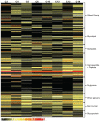Anti-glycan IgM repertoires in newborn human cord blood
- PMID: 31365539
- PMCID: PMC6668783
- DOI: 10.1371/journal.pone.0218575
Anti-glycan IgM repertoires in newborn human cord blood
Abstract
Natural antibodies are an innate-like subset of serum antibodies involved in host defense, tumor surveillance, homeostasis, and autoimmunity. Defining the natural antibody repertoire is critical for identifying biomarkers, developing vaccines, controlling and preventing autoimmunity, and understanding the development and organization of the immune system. While natural antibodies to protein antigens have been studied in depth, little is known about natural antibodies to carbohydrate antigens. To address this, we profiled IgM from umbilical cord blood and matched maternal sera on a glycan microarray. Since standard methods to detect maternal contamination in cord serum did not have sufficient sensitivity for our study, we developed a highly sensitive microarray-based assay. Using this method, we found that over 50% of the cord samples had unacceptable levels of maternal contamination. For the cord samples with high purity, anti-glycan IgM antibodies were prevalent and recognized a broad range of non-human and human glycans. Using principal component analysis and hierarchical clustering, cord IgM repertoires showed a high degree of similarity with each other but were distinct from maternal IgM repertoires. Our results demonstrate that many anti-glycan antibodies in human serum are natural antibodies and provide new insights into the development of anti-glycan antibody repertoires.
Conflict of interest statement
The authors have declared that no competing interests exist.
Figures







Similar articles
-
Limited Neonatal Carbohydrate-Specific Antibody Repertoire Consecutive to Partial Prenatal Transfer of Maternal Antibodies.Front Immunol. 2020 Oct 14;11:573629. doi: 10.3389/fimmu.2020.573629. eCollection 2020. Front Immunol. 2020. PMID: 33162988 Free PMC article.
-
Factors Affecting Anti-Glycan IgG and IgM Repertoires in Human Serum.Sci Rep. 2016 Jan 19;6:19509. doi: 10.1038/srep19509. Sci Rep. 2016. PMID: 26781493 Free PMC article.
-
Competition between serum IgG, IgM, and IgA anti-glycan antibodies.PLoS One. 2015 Mar 25;10(3):e0119298. doi: 10.1371/journal.pone.0119298. eCollection 2015. PLoS One. 2015. PMID: 25807519 Free PMC article.
-
The natural autoantibody repertoire in newborns and adults: a current overview.Adv Exp Med Biol. 2012;750:198-212. doi: 10.1007/978-1-4614-3461-0_15. Adv Exp Med Biol. 2012. PMID: 22903676 Review.
-
Regulation of the immune response by natural IgM: lessons from warm autoimmune hemolytic anemia.Curr Pharm Des. 2003;9(23):1871-80. doi: 10.2174/1381612033454397. Curr Pharm Des. 2003. PMID: 12871191 Review.
Cited by
-
Glycan Reactive Natural Antibodies and Viral Immunity.Viral Immunol. 2020 May;33(4):266-276. doi: 10.1089/vim.2019.0136. Epub 2019 Dec 17. Viral Immunol. 2020. PMID: 31851873 Free PMC article. Review.
-
Limited Neonatal Carbohydrate-Specific Antibody Repertoire Consecutive to Partial Prenatal Transfer of Maternal Antibodies.Front Immunol. 2020 Oct 14;11:573629. doi: 10.3389/fimmu.2020.573629. eCollection 2020. Front Immunol. 2020. PMID: 33162988 Free PMC article.
-
CarbArrayART: a new software tool for carbohydrate microarray data storage, processing, presentation, and reporting.Glycobiology. 2022 Jun 13;32(7):552-555. doi: 10.1093/glycob/cwac018. Glycobiology. 2022. PMID: 35352122 Free PMC article.
-
Emergence and significance of carbohydrate-specific antibodies.Genes Immun. 2020 Aug;21(4):224-239. doi: 10.1038/s41435-020-0105-9. Epub 2020 Aug 5. Genes Immun. 2020. PMID: 32753697 Free PMC article. Review.
-
Corpora Amylacea in the Human Brain Exhibit Neoepitopes of a Carbohydrate Nature.Front Immunol. 2021 Jun 28;12:618193. doi: 10.3389/fimmu.2021.618193. eCollection 2021. Front Immunol. 2021. PMID: 34262556 Free PMC article.
References
-
- Khasbiullina N. R.; Bovin N. V., Hypotheses of the origin of natural antibodies: A glycobiologist’s opinion. Biochemistry (Moscow) 2015, 80, (7), 820–835. - PubMed
Publication types
MeSH terms
Substances
Grants and funding
LinkOut - more resources
Full Text Sources
Medical

